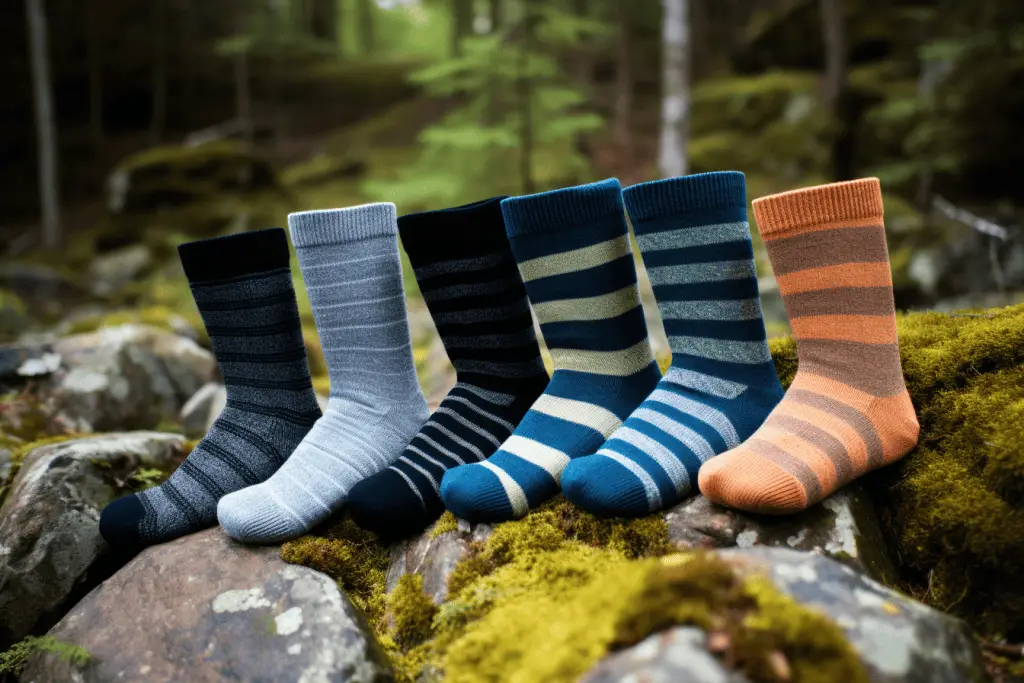Hiking socks are your first line of defense against the elements. They wick away moisture when it’s hot, provide insulation when it’s cold, and offer extra cushioning to avoid blisters. They even help reduce foot fatigue by minimizing the impact of each step. By choosing the right material – like polyester or merino wool – you can amplify these benefits to suit your trail needs. In this post, we’re going to delve deep into the battle of the fabrics – polyester vs merino wool hiking socks – to help you make an informed decision for your next adventure.

Understanding the Materials: Polyester and Merino Wool
Polyester is a synthetic material that’s the brainchild of scientists. Polyester is known for its strength and durability, making it the marathon runner of fabrics. It’s also hydrophobic, which is a fancy way of saying it hates water. This quality allows it to wick away moisture, keeping your feet relatively dry. But while it’s great at repelling water, it’s not so adept at absorbing it, which can lead to a bit of a humid environment inside your sock if you’re sweating a lot.
On the other side of the ring, we have merino wool. Don’t let the word ‘wool’ trick you into thinking it’s just for those icy treks. This natural fabric, sourced from merino sheep, is a true all-rounder. It has the ability to manage moisture by absorbing it, which helps to keep your feet comfortable and dry. Plus, it’s a champ at temperature regulation. Whether you’re in frosty mountains or sunny plains, merino wool has got your back (or should I say, foot?).

Not only that, but merino wool has another ace up its sleeve. It’s naturally resistant to odors. Thank merino sheep’s lanolin (a type of wool grease) for that. So, if you’re on a multi-day hike with no chance of laundry, merino wool socks might just be your new best friend.
To sum it up, both polyester and merino wool have their strengths and weaknesses. Polyester is like the sturdy, resilient friend who’s not quite as adaptable, while merino wool is the flexible, comfort-loving buddy who might need a bit more care. Knowing their characteristics can help you choose the right sock for your hiking escapades. Now, let’s pit these two against each other in some more specific scenarios.
Pros and Cons of Polyester Hiking Socks
Polyester hiking socks – they’ve been a go-to for outdoor enthusiasts for years, but are they really the best choice for your next trek? As with most things in life, the answer isn’t exactly straightforward. Polyester, a synthetic material hailed for its durability and moisture-wicking properties, certainly has its strengths on the trail. But it also has a few drawbacks that could be deal-breakers for some hikers. Let’s peel back the layers and see what makes polyester hiking socks a hit and miss in the wild outdoors.
Advantages of Polyester Hiking Socks:
- Durability: Polyester is known for its toughness. It can withstand strenuous hikes and frequent washes without losing its shape or color.
- Moisture Wicking: Its hydrophobic nature allows it to repel water and wick sweat away from your skin, helping keep your feet dry and reducing the risk of blisters.
- Quick Drying: If your socks get wet or if you need to wash them during a multi-day hike, polyester dries out pretty fast, ready for your next adventure.
Disadvantages of Polyester Hiking Socks:
- Breathability: Although good at wicking moisture away, polyester is not the best at absorbing it. Your feet might feel a bit clammy during intense physical activity.
- Temperature Regulation: Polyester might not offer enough insulation when it’s cold. It keeps your feet cooler in hot weather but may not be warm enough in colder climates.
- Odor Resistance: Polyester doesn’t naturally resist odors. After a few days on the trail, your socks might start giving off a noticeable smell.
So, that’s the story with polyester hiking socks. They’re tough, wick moisture well, and dry quickly. But they might make your feet feel clammy, don’t insulate very well in cold weather, and aren’t the best at preventing odors. It’s a bit of a mixed bag, so your choice might depend on the specific conditions of your hike.
Here’s a table summarizing the advantages and disadvantages of polyester hiking socks:
| Pros | Cons |
|---|---|
| Durable and long-lasting | Not as breathable |
| Good moisture wicking | May feel clammy in intense heat |
| Maintains shape and color well | Not as insulating in cold weather |
| Dries quickly | Not naturally odor-resistant |
Pros and Cons of Merino Wool Hiking Socks
Alright, we’ve unpacked polyester, but what about merino wool hiking socks? These natural wool wonders have gained quite a reputation in the hiking community, praised for their superior comfort and temperature regulation. But are they the holy grail of hiking socks that they’re often made out to be? Well, as with most things, there’s more to the story. Just as they have their virtues, merino wool socks also come with a few caveats. So, let’s tread into the terrain of merino wool, exploring both its peaks and valleys in the hiking sock realm.
Advantages of Merino Wool Hiking Socks:
- Moisture Management: Merino wool can absorb up to 30% of its weight in moisture, which keeps your feet dry and comfortable, even when you’re breaking a sweat.
- Temperature Regulation: Merino wool excels at keeping your feet warm in cold weather and cool in hot weather. It’s a natural insulator that adjusts according to your body’s needs.
- Odor Resistance: Thanks to its natural antimicrobial properties, merino wool is great at keeping odors at bay. Even after a few days on the trail, your socks won’t stink.
Disadvantages of Merino Wool Hiking Socks:
- Durability: While merino wool is pretty strong, it’s not as durable as synthetic materials like polyester. It may wear out quicker, especially in areas of high friction like the heels and toes.
- Drying Time: Merino wool doesn’t dry as quickly as polyester. If your socks get wet on the trail or after a wash, they might take a while to dry.
- Care: Merino wool requires a bit more care when washing. It can shrink in high heat, so you have to be careful when laundering.
So, merino wool hiking socks have their own set of pros and cons. They’re excellent at managing moisture, regulating temperature, and resisting odor. However, they might not be as durable, take longer to dry, and require more care compared to their polyester counterparts. As with polyester socks, your choice will depend on the specific needs of your hiking adventure.
Here is a table summarizing the advantages and disadvantages of merino wool hiking socks:
| Pros | Cons |
|---|---|
| Excellent moisture management | Not as durable as polyester |
| Superior temperature regulation | Longer drying time |
| Naturally odor-resistant | Requires careful laundering to avoid shrinking |
What About Hybrid Hiking Socks?
When it comes to hiking socks, it’s not always a clear-cut choice between polyester and merino wool. Often, you’ll find socks that are a mix of both or have other materials thrown into the blend. The aim is to take advantage of the best characteristics of each material, creating a hiking sock that ticks all the boxes.
Polyester/Wool Blends
Polyester-merino wool blends, for example, are pretty popular. You get the durability and quick-drying properties of polyester mixed with the moisture-absorbing and temperature-regulating attributes of merino wool. It’s like getting the best of both worlds in one sock. And let’s not forget the added bonus of merino’s natural odor resistance, which can be a game-changer on multi-day hikes.
Nylon and Elastane Blends
Then there’s the addition of materials like nylon and elastane (also known as spandex). Nylon is often added to the mix to enhance the durability of the sock. It’s strong, lightweight, and resistant to abrasion, making it perfect for withstanding those long, rugged treks. Elastane, on the other hand, adds stretch and ensures the sock maintains its shape, giving you a snug, comfortable fit.
In a nutshell, blends can offer a balanced package of durability, comfort, moisture management, and fit. However, the proportions of each material in the blend can significantly affect the sock’s performance. So, it’s a good idea to check the blend percentages when shopping for your hiking socks. After all, it’s not just about choosing the right materials, but also about finding the right mix that suits your hiking style and conditions.
Frequently Asked Questions
Are merino wool socks better than polyester for hiking?
Both types of socks have their advantages. Merino wool socks are excellent for temperature regulation and odor resistance, making them great for multi-day hikes. However, polyester socks are more durable and dry faster, which can be beneficial in certain conditions. The best choice depends on your specific hiking needs and preferences.
Can I wear polyester socks in cold weather?
Polyester socks can be worn in cold weather, but they might not provide as much insulation as merino wool socks. If you plan on hiking in very cold conditions, merino wool would be a better option due to its natural insulating properties.
Do merino wool socks need special care?
Merino wool socks should be washed in cold water on a gentle cycle, and air-dried if possible. They can shrink in high heat, so avoid using a hot wash or a hot dryer.
Which type of sock is more durable – polyester or merino wool?
Generally, polyester socks are more durable than merino wool socks. They resist wear and tear better, especially in high-friction areas like the heels and toes.
Are merino wool socks worth the higher price?
Many hikers find the extra cost of merino wool socks to be worth it for the comfort, temperature regulation, and odor resistance they provide, especially on longer hikes. However, the value for money will depend on your individual hiking needs and the specific conditions you’ll be hiking in.
Are polyester socks bad for the environment?
Polyester is a type of plastic, which is derived from fossil fuels, and it can take hundreds of years to break down in the environment. However, many manufacturers are now using recycled polyester, which is a more sustainable option.
Do merino wool socks smell?
Merino wool has natural antimicrobial properties, which can help to reduce odors. This can be particularly beneficial on multi-day hikes where you can’t wash your socks every day.
